One-step implementation of plasmon enhancement and solvent annealing effects for air-processed high-efficiency perovskite solar cells†
Abstract
Facile fabrication and high performance are crucial for the commercialization of perovskite solar cells (PSCs). As an efficient and promising electron-transporting material, ZnO has attracted much attention recently, while the power conversion efficiency (PCE) of ZnO-based PSCs is still inferior to that of TiO2-based PSCs. In this work, we demonstrate that the Au nanorod (NR) suspension spin-coated at the interface between the electron transport layer (ETL) and the perovskite layer provides both plasmon enhancement and solvent annealing effects. Surface plasmon resonance (SPR) offers strong light absorption over almost the whole visible-light range. Meanwhile, plasmon-induced hot electrons transferring from Au NRs to the ZnO film result in reduced trap-state density, restrained charge recombination, and efficient electron transport in the ETL, which could suppress photocurrent hysteresis to some extent. Interestingly, the introduction of N,N-dimethylformamide (DMF), which is originally used for dispersing Au NRs, yields a high-quality perovskite film. As a result, the PCE of our champion cell with the structure of FTO/ZnO/Au NRs/CH3NH3PbI3/spiro-OMeTAD/Au surges to 16.51% from 14.47%. Moreover, the devices show an excellent environmental stability, where the average PCEs can be maintained at about 90% of their original value after storing for as long as two months (>1400 h) under air conditions. Notably, the fabrication of PSCs was totally conducted under ambient air without control of oxygen and humidity, which would help in industrial production. This work provides a new approach to substantially improve the quality of perovskite and ETL films for air-processed high-efficiency PSCs.



 Please wait while we load your content...
Please wait while we load your content...